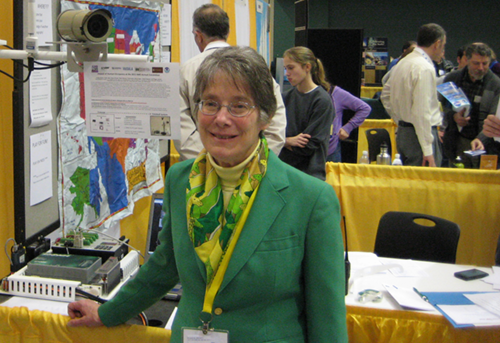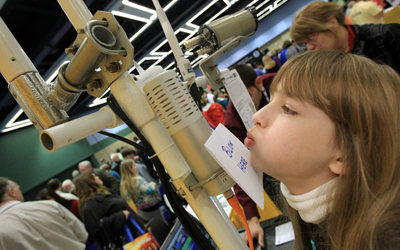Experiment During Annual AMS Conference
PSL researcher, colleagues set up equipment to measure human impact on meeting environment

Peggy LeMone, president of the American Meteorological Society (AMS), had an inspiration for this year's annual conference. Since the theme was about communicating climate, she wanted an informal, real-time experiment run during the conference, to demonstrate how people affect the environment.
At the most basic level, people modify immediate surroundings simply by body heat and breathing. At another level, our buildings have great impact: to keep conditions comfortable indoors, most buildings must get rid of excess heat through HVAC (Heating, Ventilating, and Air Conditioning) systems. Collectively, buildings help make cities warmer than rural areas.
LeMone asked meteorologists Dan Wolfe of ESRL's Physical Sciences Laboratory and Collin Daly of Campbell Scientific, both of them experts in creating and deploying meteorological instruments, to develop a monitoring system to measure room conditions and changes during AMS.
"We've used similar monitoring systems for research experiments on land, ships and aircraft to study boundary layer and climate processes," said Wolfe. Components for the indoor analysis system were provided by Vaisala and LICOR, integrated by Campbell Scientific, and tested by Wolfe and Daly.
LeMone also wanted to engage students attending the conference by involving them in the study. About 10 students volunteered, learning from Wolfe and Daly how to assemble equipment and monitor data.
Two identical systems measured temperature, relative humidity, and CO2 data at different locations throughout the convention center. Data were transmitted by cell phone in real time to Campbell Scientific, and made available on the company's website and via smart phone; all conference attendees had access.
The system was first tested at the AMS exhibit during WeatherFest, an interactive science fair open to the public. "Students working in the booth enthusiastically explained to visitors how our system operated and our objective," said Wolfe.
The primary monitoring location was at the Presidential Forum, with about 1,400 participants. Calculations before the event showed the potential for significant increases in temperature and CO2 readings, not factoring in the HVAC. To make things more interesting, the HVAC system was discreetly turned off for 25 minutes during the Forum. This was long enough to see a change in the data signal, without a major impact on people's comfort.
At the request of LeMone, Professor David Sailor of Portland State University gave a talk the next day at a Town Hall meeting on the "Impact of Human Occupancy at the 2011 AMS Annual Convention." Sailor didn't have much time to analyze the data before his talk, but as expected, CO2 and temperature levels fluctuated as occupancy changed. When the HVAC was shut off, the temperature and CO2 level rose more rapidly – with CO2 reaching nearly 1100 ppm (ambient atmospheric levels average about 390 ppm).
"Neither CO2 nor water vapor nor temperature rose as much as we thought it would," said Sailor, "because the room was still in 'communication' with other parts of the building and created suction."The room wasn't completely sealed off, allowing air to rush in through open doors and adjacent spaces, decreasing the expected impact.
At the end of the Presidential Forum, session surveys were handed out that included questions about room acoustics and temperature. More than 500 surveys were returned and are in the process of being collated and reviewed. Sailor said that thus far, there is a trend suggesting that the conference rooms tend to be too cool, which could mean wasted energy and money.
Sailor will attend a different conference at the same venue in the near future, and may revisit the experiment. In the coming months, he hopes to do a detailed analysis of the data and perhaps publish the results in the Bulletin of the American Meteorological Society.
Many conference attendees who Wolfe spoke with thought the experiment was a great idea. "We were able to accomplish more than initially anticipated, because of the efforts of all those involved," said Wolfe.
By Barb DeLuisi, Winter 2011

